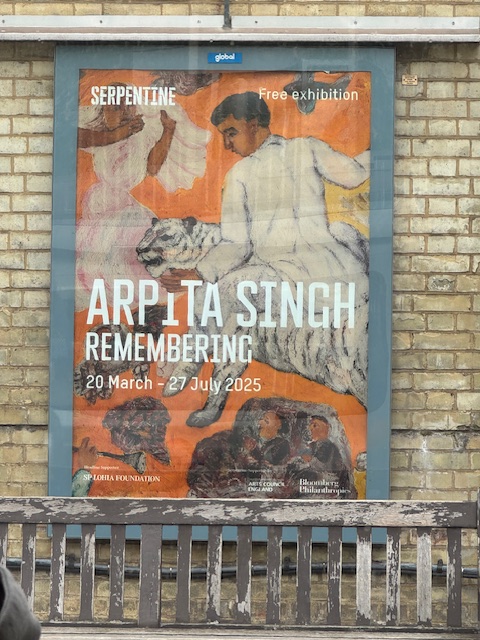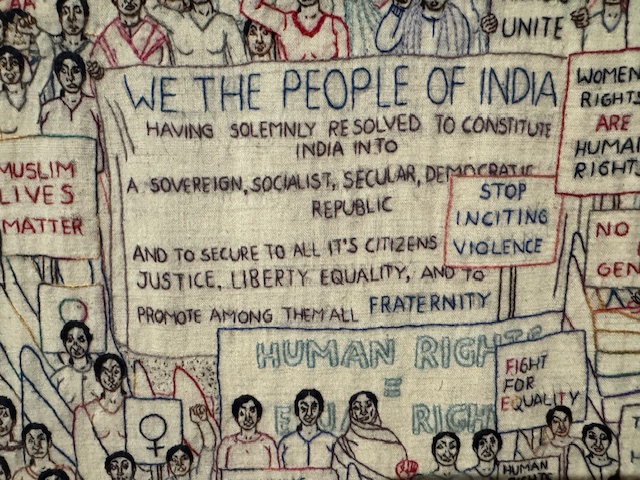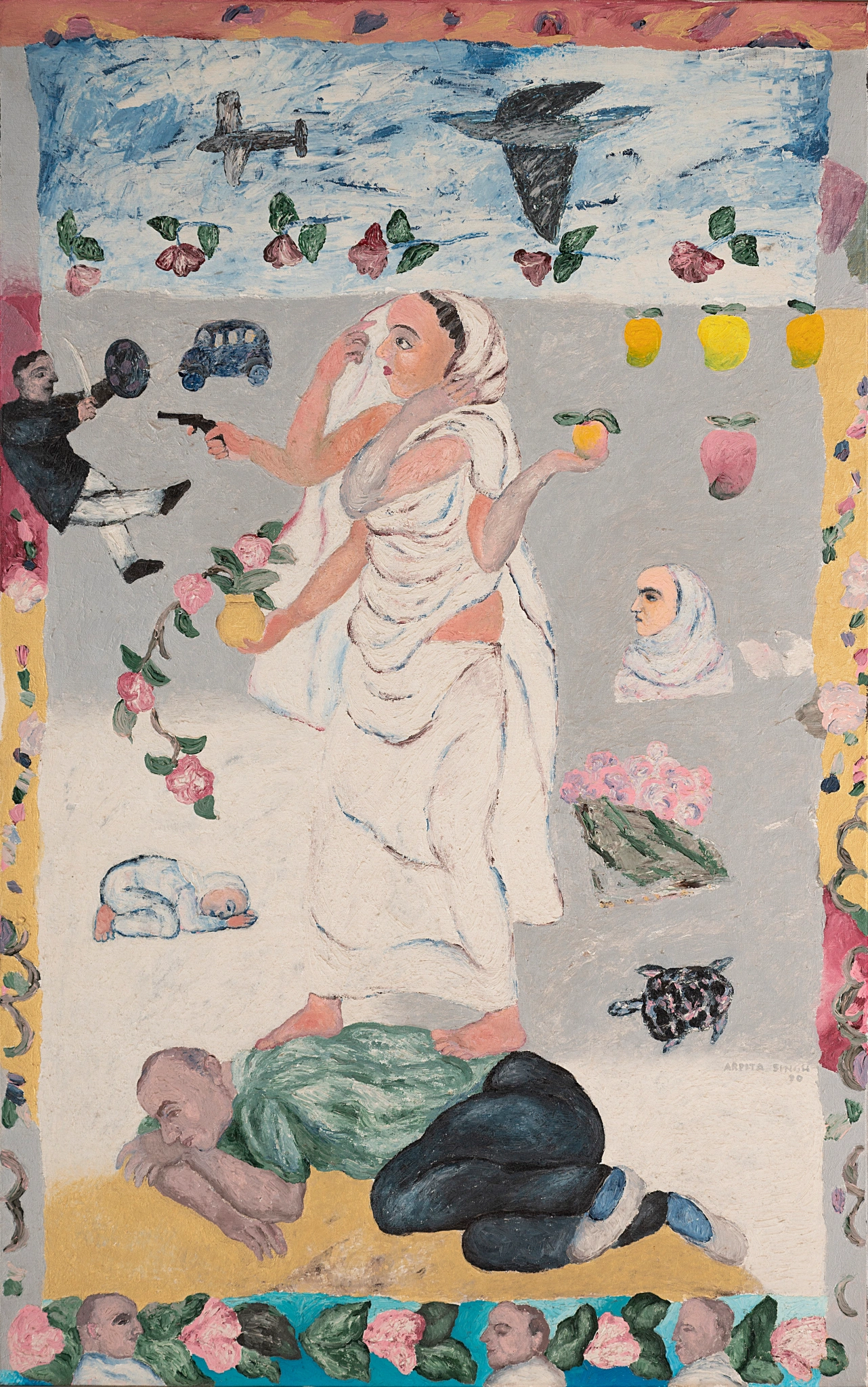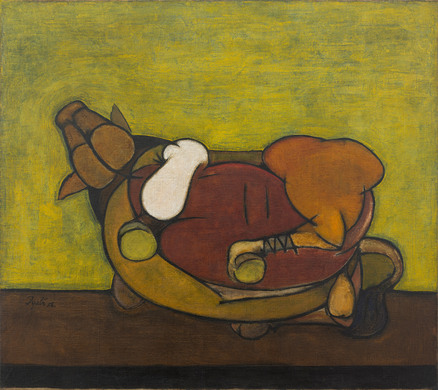Veteran Indian Artist Arpita Singh Stars in London’s Hyde Park
Six months after an exhibition was held at London’s Barbican Centre showing India modern art from the end of the last century, a retrospective has opened in a Hyde Park gallery of works by Arpita Singh, 87, a respected but under-recognised Indian artist whose large oils on canvas portray the complex crosscurrents of Indian life.
Staged in the Serpentine Gallery North till July 27, this is Singh’s first solo show outside India

A poster at a London tube station based on “Man on Tiger with Clay Bird”, a 1991 oil on canvas.
“Arpita talks about violence, wars and aggression, and all sorts of injustice, while using the language of play, always humour jest and wit,” her friend and fellow artist Nilima Sheikh told me earlier this year. “She’s reluctant to talk about the content of her art, instead she talks about the process, the way she uses oil on canvas.”
This coincides with another exhibition – (Un)Layering the Future Past – at London University’s SOAS of 26 young artists (most born in the 1980s) from across South Asia.
The aim here is to spread artistic awareness of different South Asian countries’ social and other issues such as the region’s ecology, gender, migration and political unrest with a mix of paintings and drawings, textiles and installations.
Sponsored by Delhi’s Dhoomimal Gallery memorial trust, it is on show till June 21 and has been co-curated by Salima Hashmi, a veteran Pakistani artist and professor based in Lahore. “We come back to the old colonial capital to talk to one another,” she told me, lamenting Pakistani artists’ lack of visa access to India and other restrictions on freedom of expression.
“Artists have to be first responders,” she says. Recent generations of artists in India had been more focused on galleries’ requirements than on issues. “In Lahore we question everything.”

A detail from “The Longest Revolution”, an embroidery at SOAS by Nagpur-based Varunika Saraf. (c Chemould Gellery Mumbai)
Though Hashmi doesn’t approve of the commercialisation of many artists younger than Arpita Singh and her fellow Baroda school, both exhibitions are significant at a time when the Indian art market is growing rapidly with record multi-million-dollar auction prices.
London is becoming a focal point for exhibitions. Sculptures by Homi Bhabha, a Pakistani-American, will be on show at the Barbican next month, and an exhibition centred around the Indian sculptor Mrinalini Mukherjee will open at the Royal Academy at the end of October.

Arpita Singh.
It is tempting to describe Singh’s large oils as cluttered or as a cacophony, but that would be too negative for her complex rendering of Indian life with a seemingly unstructured array of women and men standing, lying, or sitting among landscapes and townscapes that include cars, buildings and (almost always) disconnected aeroplanes.
The exhibition is titled Remembering, which led The Guardian newspaper to headline its review “Beautiful chaos reigns in India’s tumultuous past”. My main memories seeing the works at various times in India has been of a recurring sky-blue colour with the small aircraft appearing in most works, replaced later by guns, military figures and fighters. Sheikh told me the aircraft were to create a “sense of wonderment” for children.
The artist’s more approachable smaller watercolours and seminal ink line drawings are closely packed at the Serpentine with scarce description in two darkish anonymous corridors that straddle the gallery. More easily accessible interpretation is needed for people who drop in on an afternoon’s walk across Hyde Park and Kensington Gardens, to begin to appreciate the artist’s messages. Even experts find that challenging.
“Look for secret trapdoors and open sesame codes if you like, but mind you, if you begin to think the meaning is more important than the game….you may well trip up,” warns Sheikh in the catalogue.
A 1989 oil, Munna Apa’s Garden is one of the most puzzling works . It looks at first like a random mix of homely scenes till one spots a body lying in the middle, which everyone seems to be ignoring. “Scales and perspectives don’t entirely make sense, as cars and airplanes are superposed onto a bed of flowers. Nor does one entirely understand what has gone wrong in this enchanting setting,” says the catalogue.

Munna Apa’s Garden, a 1989 oil on canvas.
Even more puzzling is Devi Pistol Wali where the supreme Hindu goddess Devi stands on a man in the style of the goddess Kali who’s sometimes depicted standing on the chest of Lord Shiva. Devi is pointing a pistol at a man with a sword accompanied by the usual aeroplane car and a turtle.

Devi Pistol Wali, 1990.
Other works seem to reflect a change of mood down the years from a relatively gentle interpretation of Indian life to despair if not anger at developments of heavy government and bureaucracy, violence and wars.
Exhibitions usually increase auction interest so it’s quite likely Singh will hit new records soon. Her highest dollar price of $2.24m was achieved at a Saffronart sale in December 2010 for a large 16-panel canvas titled Wish Dream. That was the dollar equivalent of the Rs9.6 crore (Rs96m) auction price at the then exchange rate. It was beaten by Rs11 crore (Rs110m) paid in a Pundole (Mumbai) auction in August 2023 for Watching, by which time the rupee had fallen in value, so it translated as only $1.33m.
Wealthy bid $millions
Recent auction records have been for works by the renowned Progressive group who began painting in the middle of the last century. At the Saffronart auction earlier this month, a record Tyeb Mehta, Trussed Bull, (below) had eight bidders up to nearly $4m, after which two fought it out to reach a total of $7.2m, twelve times the top estimate. The auction had record $25.2m total sales.
That followed a totally unexpected record of $13.75m for a memorable work by M.F.Husain, another member of the Progressives, that was taken so far above the expected $4m-$5m by two bidders that it may take some time to beat.

Tyeb Mehta’s 37in x 41in oil on canvas.
“There’s a mindset change with the wealthy of India finally accepting art as the best legacy to leave behind, the legacy of culture,” says Dinesh Vazirani, co-founder and director of Saffronart which is India’s leading auction house. “New buyers are coming in at serious values that I’ve not seen before with budgets of £2m to $5m – individuals as well as museums”.
In July, a London exhibition aimed at these rich buyers will have works for sale by more than 40 of South Asia’s top artists. It is being staged by the London-based South Asia-oriented Grosvenor Gallery with Phillips, a leading auction house that does not usually handle Indian art. It is carefully timed to coincide with the Wimbledon tennis tournament and India-England cricket match at Lord’s. “Everyone will be in town,” says Conor Macklin, founder director of he Grosvenor.
This article went live on April twenty-third, two thousand twenty five, at fifteen minutes past one in the afternoon.The Wire is now on WhatsApp. Follow our channel for sharp analysis and opinions on the latest developments.




